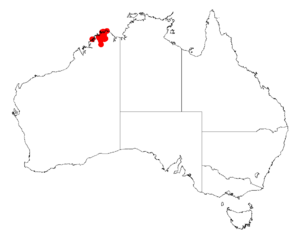Acacia areolata facts for kids
Quick facts for kids Acacia areolata |
|
|---|---|
| Scientific classification | |
| Genus: |
Acacia
|
| Species: |
areolata
|
 |
|
| Occurrence data from AVH | |
Acacia areolata is a type of shrub or small tree. It belongs to the Acacia family, which is also known as wattles. This plant is special because it is found only in the northwestern part of Australia. When a plant or animal is found only in one specific area, it's called endemic.
What Does It Look Like?
This plant usually grows as a shrub about 3 metres (10 ft) tall and spreads out. Sometimes, it can even grow into a small tree, reaching up to 8 m (26 ft) high! It rarely grows flat along the ground, which is called prostrate.
Bark and Branches
The bark of Acacia areolata is grey-brown and has a cracked or "fissured" texture. Its new shoots are sticky (resinous) and smooth (glabrous), with a rusty-brown color. The branches are a bit flat and also smooth. They can be grey or reddish and often have a fine white powder on them.
Leaves and Flowers
Like many Acacia species, this plant doesn't have true leaves. Instead, it has what are called phyllodes. These are flattened leaf-like stems that do the job of leaves. The green phyllodes are often covered in a white powdery coating too. They are usually straight and shaped like half an oval, or sometimes a full oval. These smooth phyllodes are about 6 to 16 cm (2.4 to 6.3 in) long and 20 to 40 mm (0.79 to 1.57 in) wide. They have three to five clear lines, or veins, running along them.
Acacia areolata blooms in September, producing bright yellow flowers.
Where Does It Grow?
This plant is found naturally in the Kimberley region of Western Australia. Its range stretches from around Cape Londonderry in the north down to the Carson Escarpment in the south, all within the northern Kimberley area.
It typically grows in soils that are rich in iron, called lateritic soils, or in sandy soils that come from sandstone. You can usually find it growing in open woodland areas, where trees are spread out and there's plenty of sunlight.

